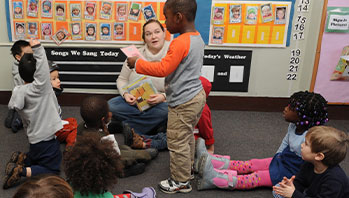- chart paper, marker
MA Standards:
English Language Arts/Foundational Skills/RF.PK.MA.2.c: Identify the initial sound of a spoken word and, with guidance and support, generate several other words that have the same initial sound.
Head Start Outcomes:
Literacy Knowledge/Alphabet Knowledge: Recognizes that letters of the alphabet have distinct sound(s) associated with them.
Literacy Knowledge/Alphabet Knowledge: Attends to the beginning letters and sounds in familiar words.
PreK Learning Guidelines:
English Language Arts/Reading and Literature 7: Develop familiarity with the forms of alphabet letters, awareness of print, and letter forms.
English Language Arts/Reading and Literature 8: Listen to, identify, and manipulate language sounds to develop auditory discrimination and phonemic awareness.
Word Play: Alliteration (/g/)

© Commonwealth of Massachusetts, Department of Early Education and Care (Jennifer Waddell photographer). All rights reserved.
ELA Focus Skills: Letter Formation, Phonological Awareness (Beginning Sounds), Vocabulary
Model how to form the uppercase and lowercase “Gg” as you write an alliterative sentence for children. Write the following on chart paper, reading each word slowly as you write.
Goldie giggled at the garlic.
Explain that the sentence has a lot of words that start with the same sound. Have children listen as you read the sentence aloud, stressing the /g/ sound. Ask, What sound do you hear at the beginning of most of these words?
Have children say the sentence along with you, faster and faster. Remind them that sentences with lots of words beginning with the same sound are called “tongue twisters.”
Take It Further: Help interested children make up more alliterative sentences of their own. Read the sentences, faster and faster.
Adaptation: With very young children, you may wish to simply say the alliterative sentences slowly with them and not do the tongue twisting, which might become frustrating for some.
